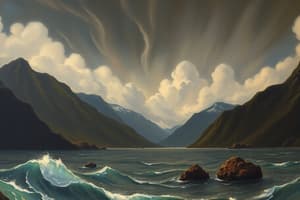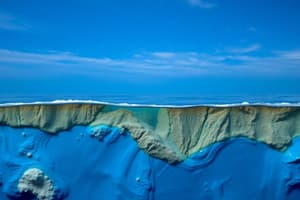Podcast
Questions and Answers
When did the supercontinent of Pangaea exist?
When did the supercontinent of Pangaea exist?
about 200 million years ago
What was the ocean that surrounded the supercontinent Pangaea called?
What was the ocean that surrounded the supercontinent Pangaea called?
Panthalassa
Which of the following lines of evidence did Alfred Wegener use to support his idea of continental drift? (Select all that apply)
Which of the following lines of evidence did Alfred Wegener use to support his idea of continental drift? (Select all that apply)
- Matching rock sequences and mountain ranges on different continents (correct)
- Fossil similarities in widely separated continents
- The fit of the continental margins across ocean basins (correct)
- Climate evidence such as glacial deposits in warmer areas (correct)
Scientists of Wegener's time accepted the idea of continental drift.
Scientists of Wegener's time accepted the idea of continental drift.
Describe Earth's magnetic field.
Describe Earth's magnetic field.
How has Earth's magnetic field changed through time?
How has Earth's magnetic field changed through time?
How do sea turtles use Earth's magnetic field for navigation?
How do sea turtles use Earth's magnetic field for navigation?
What is sea floor spreading?
What is sea floor spreading?
Why does a map of worldwide earthquakes closely match the locations of worldwide plate boundaries?
Why does a map of worldwide earthquakes closely match the locations of worldwide plate boundaries?
Why do most lithospheric plates contain both oceanic- and continental-type crust?
Why do most lithospheric plates contain both oceanic- and continental-type crust?
Describe the differences between oceanic ridges and oceanic rises.
Describe the differences between oceanic ridges and oceanic rises.
Flashcards are hidden until you start studying
Study Notes
Pangaea and Panthalassa
- Pangaea existed approximately 200 million years ago.
- The surrounding ocean was called Panthalassa, the largest ocean at that time.
Evidence for Continental Drift
- Alfred Wegener's evidence for continental drift includes:
- Fit of Continents: The margins of continents align across oceans.
- Rock Sequences: Similar rock layers and mountain ranges found on different continents.
- Climate Evidence: Glacial deposits discovered in equatorial regions, suggesting historical climate changes.
- Biological Distribution: Organisms found on separate continents that theoretically could not have crossed the oceans.
- Wegener's ideas were initially doubted due to a lack of plausible mechanisms for continental movement, conflicting with physics of the early 20th century.
- Sea floor spreading data in the 1950s and 1960s supported and advanced Wegener's theories.
Earth's Magnetic Field
- Resembles a bar magnet, with north (N) and south (S) poles indicating opposite charges.
- Magnetic force lines extend from Earth's core into space.
- The strength of Earth's magnetic field has fluctuated over time, with numerous polarity reversals during the last 100 million years.
Sea Turtles and Navigation
- Sea turtles utilize Earth's magnetic field for navigation through a process called magnetoreception.
- Hatchling turtles can differentiate between magnetic inclination angles, which helps them identify latitude.
- Research shows turtles can detect magnetic field intensity, assisting in the creation of a navigational magnetic map.
- This magnetic map enables sea turtles to find locations like breeding islands miles away.
Sea Floor Spreading
- Characterized by symmetric stripes of age on either side of mid-ocean ridges, indicating ongoing sea floor movement.
- Provided compelling evidence that helped unify the theories of continental drift and plate tectonics.
Earthquakes and Plate Boundaries
- Earthquakes are closely linked to plate boundaries, marking areas of plate interaction.
- High incidences of earthquakes occur at convergent and transform plate boundaries.
Lithospheric Plates
- Most lithospheric plates encompass both oceanic and continental crust.
- Plate boundaries do not strictly adhere to continental margins, leading to the inclusion of both crust types in larger plates.
Oceanic Ridges vs. Oceanic Rises
- Oceanic ridges and rises differ primarily in terms of their spreading rates, affecting the geography and geological characteristics of ocean basins.
Studying That Suits You
Use AI to generate personalized quizzes and flashcards to suit your learning preferences.





